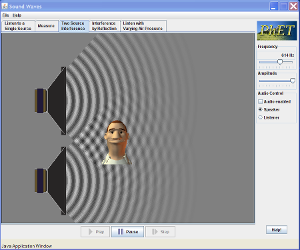Laboratory Activities:
You will be working in groups on most lab activities. Your log book (lab book or lab journal) does not have to be "neat" but it must be organized. Make sure to put all pertinent information in your log book. Staple or tape graphs or data that you have printed so that they do not fall out. If you do not know how a particular piece of apparatus works read a Lab Equipment Manual or ask [other groups are great resources too!].
VPython |
|
To run a Python program you will need to opentheVIDLE program which is a GUI (graphical user interface) for Python. |
|
Date |
#
|
Description
|
Simulations from PhET | |
|
Monday
Aug. 27 |
0 |
Use the least force to lift a 2 kg mass.
|
||
Tuesday Aug. 28 |
1 | Analog Lab: Simple Motion Use simulations to visualize motion and vectors. Computer Simulation: Vector Position |
 Moving Man |
 Vector Addition |
Tuesday Sept. 4 |
2 | Analog Lab: Complex Motion Use simulations to visualize 2D motion. Use this basketball shot movie for the B-lab analysis. Computer Simulation: Changing Position |
 Projectile Motion
Projectile Motion |
 Motion in 2D
Motion in 2D |
Tuesday Sept. 11 |
3 | Analog Lab: Force and Motion Start with frictionless surfaces. Computer Simulation: Changing Velocity |
 Forces and Motion
Forces and Motion
|
 Forces in 1 Dimension
Forces in 1 Dimension
|
Tuesday Sept. 18 |
4 | Analog Lab: Drag Force
Use simulations to visualize contact friction and the forces including friction when moving an object.
Computer Simulation: Changing Force |
 Ramp: Forces and Motion
Ramp: Forces and Motion
|
 Friction
Friction
|
Tuesday Sept . 25 |
Lab Combine #1 Group review problem: Force and Motion
|
 Gravity and Orbits
Gravity and Orbits
|
 My Solar System
My Solar System
|
|
| Tuesday Oct. 2 | 5 | Analog Lab: Rockets Construct a rocket and numerically analyze its predicted trajectory . We will give you code for the thrust curves but you should compare with the Estes 1/4A3-3T data sheet and Estes 1/2A3-4T data sheet to make sure there is agreement. |
Rocket Launching (collect video for analysis) |
Using the video of your rocket launch, compare your rocket simulation with your actual rocket motion. For instance, determine the force vs time for your rocket. |
Thursday Oct. 18 |
6 | Analog Lab: Work and Energy This simulation is useful for visualizing energy conservation. Note: This is a short week so A-lab will be optional. Computer Simulation Homework: Work and Energy |
 Energy Skate Park
Energy Skate Park
|
 The Ramp
The Ramp
|
| Tuesday Oct. 23 | Lab Combine #2 Group review problem: Energy and Racing Carts Use the computer code Racing Carts and Heat Flow to help you answer these questions and/or check your answers. |
|||
Tuesday Oct. 30 |
7 | Analog Lab: Springs
and Things How do you increase the "bouncy" time? Computer Simulation: Springs - Hooke's Law |
 Masses and Springs Masses and Springs |
 Resonance Resonance |
Tuesday Nov. 6 |
8 | Analog Lab: Rotational Energy Visualize rotational kinetic energy and moment of inertia. Computer Simulation: Rotational Energy |
 Ladybug Revolution Ladybug Revolution |
|
Tuesday Nov. 13 |
|
Analog Lab: Impulse and Collisions Lunar lander is great game to play... control your momentum! Computer Simulation Homework: Collisions |
 Lunar Lander Lunar Lander |
 Collision Lab Collision Lab |
Tuesday Nov. 20 |
Individual Exam 3: Energy is quantized,Multi-particle systems and Collisions |
|||
Tuesday Nov. 27 |
10 | Analog Lab: Rolling Objects Visualize rotational kinematics. Play with the orbital motion of objects... like the solar system. Computer Simulation: Ball on a Ramp |
 Ladybug Revolution Ladybug Revolution |
 Torque Torque |
| Auxilary Lab | Analog Lab: Spinning Tops (Gyroscopes) Computer Simulation: Gyroscope |
 My Solar System My Solar System |
Cats know about conservation of angular momentum. If you doubt this then watch this video of a cat being dropped. | |
Tuesday Dec. 4 |
11 | Analog Lab: Heat Capacity Computer Simulation: States of Matter Use the computer code to help visulaize the statistical distributions for large numbers of molecules. |
 States of Matter States of Matter |
 Reversible Reactions
Reversible Reactions
|
| Auxilary Lab | Analog Lab: Sound and Wave Alternative Fluid Flow lab or Doppler Effect lab Doppler Simulation: Zip-file or Web-based Computer Simulation: Sound |
 Wave on a String
Wave on a String |
 Sound
Sound
|
|
Tuesday Dec. 11 |
12 | Final computer silumatioon project. Computer Simulation: Planetary Orbits |
||
Lab summaries are typically due one week from when they are started. This means lab summaries are typically turned in Tuesday right before starting the lab. Computer programs have individual and group component assignments. The group program is graded in lab (typically on Thursday) and is evaluated similar to the C-level. Individual programs will be turned in typically a week after they are assigned. |
| C-level: Conceptual
diagram and summary due on lab day. Students must receive a 3 (out of 4) on
the C-level to move on to the B-Level. B-level: Basic lab must be checked on lab day for A-level work to earn credit. Edited lab summaries due by following Tuesday (best to get feedback on lab day). Students must receive a 2 (out of 4) on the B-Level to move on to the A-level. A-level: Advanced lab summaries due by following Tuesday. |
| Labs are evaluated on 0=not present, 1=poor, 2=needs improvement, 3=meets expectations and 4=exceeds expectations. |
| Your percent lab grade is given by %=(5*C + 3*B + 2*A + 42)/82*100%. You may find it easier to look at a table of scores. |
